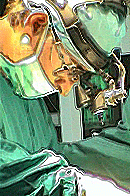|
|
|
|
|
|
|
|
The lower and "benign" end of the spectrum of fibrillary astrocytic neoplasms begins with the astrocytoma. In adults, most of these lesions arise in the cerebral hemispheres where the symptoms, especially seizures, may be of long standing. In children, the brain stem, particularly the pons, is favoured. The spinal cord is affected in both age groups. In the cerebral hemispheres, the well-differentiated astrocytoma is less common than the glioblastoma, whereas the opposite is true in the spinal cord. In any location, the neoplasm alters the colour and texture of the parent tissue, but this is most obvious in the cerebral hemispheres, where the imparted yellow stringiness of the white matter is most readily seen and felt. Cysts filled with clear yellow fluid may be seen, and gritty grains of calcium may be encountered in a minority of cases. The ill-defined borders of these lesions are reminders that complete surgical excision is an elusive goal. The brain stem lesions are similarly ill defined and may lobulate the external surface of the pons and partially surround the basilar artery. Some well-differentiated solid or cystic brain stem astrocytomas protrude into the fourth ventricle. Microscopically, the nuclei of neoplastic well-differentiated astrocytes are round and generally uniform. They congregate in a density not markedly different from that of normal white matter. Mitoses are rare, and the vascular proliferation and necrosis that characterize the glioblastoma are not observed. A helpful diagnostic feature is a vacuolated state produced by small pools of eosinophilic fluid and known as microcystic change. This is not usually found either in reactive astrocytosis or in markedly anaplastic neoplasms. The pink cytoplasm with the multiple filament-rich processes characteristic of astrocytes mayor may not be seen in standard histologic sections but are visualized by electron microscopy or staining for GFAP. These astrocytic characteristics are exaggerated in the process-laden astrocytes that predominate in the subcategory of astrocytomas known as gemistocytic astrocytomas. Recent data support the concept that gemistocytic astrocytomas behave more aggressively than expected for low-grade astrocytomas, with a tendency for more rapid evolution to glioblastoma, and many are therefore graded as anaplastic astrocytomas. The ease of histologic diagnosis of the well-differentiated astrocytoma depends on the extent to which the lesion differs from normal or gliotic brain. This difference may not be great, and a firm diagnosis may not always be possible, especially in small specimens such as those from the brain stem, spinal cord, or edge of a cerebral lesion. As much tissue as possible should be submitted for histologic studies, especially from the macroscopically most abnormal area. Frozen section examination should also be directed at this latter site to minimize the likelihood of a "consistent with" or "I think this is" diagnosis that can be the pathologist's way of hedging when there is uncertainty about the nature of the lesion.
|
|
|
Introduction |Imaging | Astrocytomas | Glioblastoma Multiforme | Oligodendrogliomas | Ependymomas | Pilocytic Astrocytomas | Gangliogliomas | Mixed Gliomas | Other Astrocytomas | Surgical treatment | Stereotactic Biopsy | Gliadel Wafers |Results and complications | When to Reoperate? | Colloid cyst
Copyright [2022] CNS Clinic - Jordan]. All rights reserved

